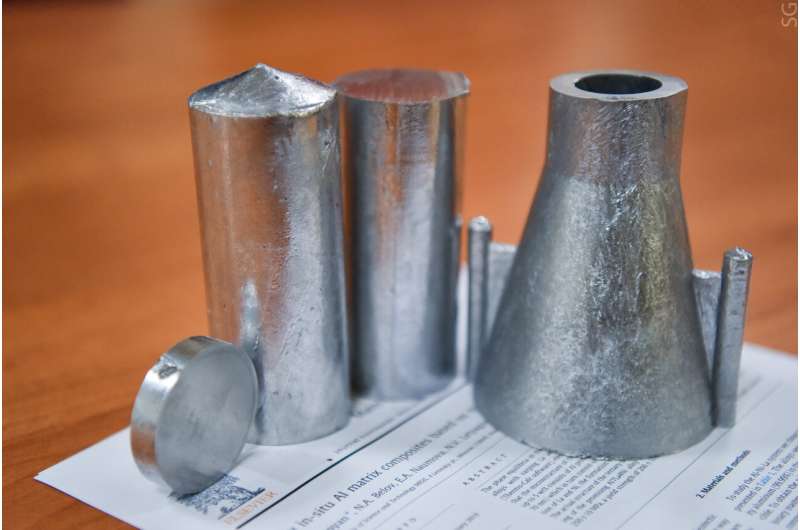Scientists create new aluminum alloy with flexibility, strength, lightness

Aluminum is one of the most promising materials for aeronautics and automobile industry. Scientists from the National University of Science and Technology (MISIS) found a simple and efficient way of strengthening aluminum-based composite materials. Doping aluminum melt with nickel and lanthanum, scientists managed to create a material combining benefits of both composite materials and standard alloys: flexibility, strength, lightness. The article on the research is published in Materials Letters.
Lighter and faster aircraft and vehicles require lighter materials. One of the most promising materials is aluminum, or rather, aluminum-based composites.
Scientists from NUST MISIS scientific school "Phase Transitions and Development of Non-Ferrous Alloys" created a new strong Al-Ni-La composite for aircraft and automobile industry. Doping elements were added to the aluminum melt, forming special chemical compounds that further formed strong reinforcing structure.
"Our research group, led by Professor Nikolai Belov, has worked on the creation of aluminum-based composites for many years. Al-Ni-La composite is one of such projects, aimed at creation of "natural" aluminum-based composite material with more than 15% vol. of doping elements. A feature of the new development is the high reinforcing ability of the chemical compounds with ultrafine structure: the diameter of the reinforcing elements does not exceed several tens of nanometers. Previously, researchers were limited to the study of systems in which it is obviously impossible to obtain an effective reinforcing structure. Or they manufactured composite materials by labor-intensive powder metallurgy methods (sintering of powders), or liquid-phase technologies of kneading nanoparticles in the melt," Torgom Akopyan, one of the authors, researcher at NUST MISIS Department of Metal Forming, comments.
Today, aluminum is reinforced mainly with the help of nanopowders, but this is an extremely expensive and time-consuming process, where the result does not always justify the cost. For example, with an increase in strength by only 5-20%, plasticity can decrease by tens of percent or even several times. In addition, the particles themselves are too large—from 100 nanometers to 1-2 micrometers, and their % vol. is low.
Development of NUST MISIS scientist solves the problem of non-uniform reinforcement and low density of "powder" composites: if a melting technique is used, after Al-Ni-La crystallization the diameter of doping particle does not exceed 30-70 nanometers. Thanks to "natural" crystallization, particles are distributed uniformly, forming a reinforcing structure. Hence, the composite becomes stronger and more flexible than its powder analogues.
"Our composite already demonstrates better characteristics than its analogues, including foreign ones. However, we are not going to stop here, and in the future we plan to continue working on the creation of more advanced, complex (3-, 4- and more-phase) and cheap composites, the production cycle of which will include the use of aluminum of technical purity and cheaper alloying components," Torgom adds.
According to scientists, the proposed material can be used primarily in aeronautics and automobile industry, as well as for the design of modern robotics, including copters, where reducing the weight of the drone is critical. Due to the peculiarities of the structure formation, the proposed material can be used for the manufacture of complex parts via 3-D printing. In addition, new developments may be of strategic importance from an economic point of view. At the moment, the main share of profit in the aluminum industry in Russia is the export of primary aluminum. The creation of new high-tech developments with increased added value will increase profits by expanding domestic and foreign markets for aluminum consumption.
More information: T.K. Akopyan et al, New in-situ Al matrix composites based on Al-Ni-La eutectic, Materials Letters (2019). DOI: 10.1016/j.matlet.2019.02.112
Journal information: Materials Letters
Provided by National University of Science and Technology MISIS




















